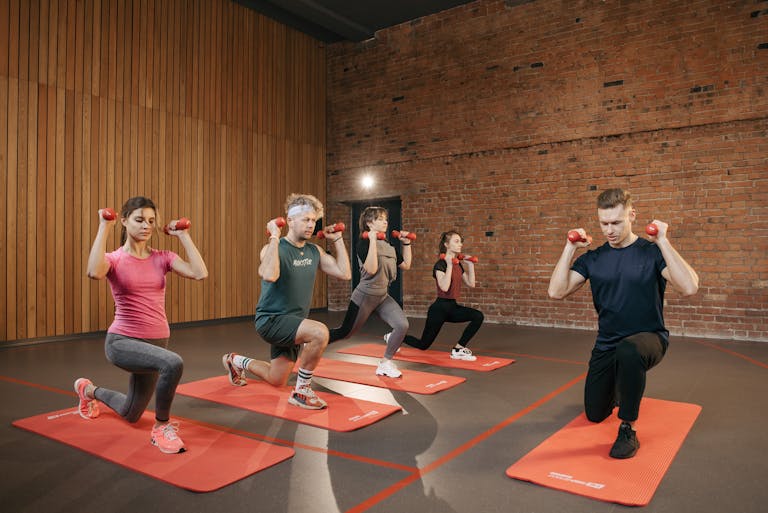Hitting a plateau in your fitness journey can be so frustrating. You’ve been putting in the work, going to the gym consistently, and following the routines, but suddenly, the progress stops. Whether it’s stalled strength gains, no weight loss, or a drop in motivation, this lack of forward momentum can leave you feeling stuck and disappointed.
A plateau is just a natural phase in fitness where progress pauses. It’s not bad, but rather a sign to reassess and adjust.
The good news? Fitness plateaus are a part of progress, and with the right approach, you can break through them. This post will help you identify the signs of a fitness plateau, understand why it’s happening, and how to overcome it. By the end, you’ll be able to reignite your progress, sustain long-term growth, and get back to enjoying the journey to your fitness goals.
What’s a Fitness Plateau
Before you can overcome a fitness plateau, you need to understand what it is and how to spot the signs that may indicate you’re in one.
What Is a Fitness Plateau
A fitness plateau happens when your body adapts to your current workout routine and progress slows down or stops. Whether your goal is to lose weight, build muscle, or improve endurance, a plateau occurs when you’re not making progress despite consistent effort.
Often, a fitness plateau involves physical adaptations as your body responds to repeated training challenges.
Signs You’re in a Plateau
- Stalled Strength Gains: You’re lifting the same weights without any increase in reps or resistance.
- No Weight Loss (or slowing down): You’ve stopped losing weight or muscle, and your body weight has been the same for weeks despite diet and exercise consistency.
- Lack of Engagement or Motivation: You feel bored, uninterested, or less excited about your workouts.
- Energy Depletion: You don’t feel as energized or strong during workouts as you used to.
Even after you’ve been consistent, progress can stall, and it’s important to recognize these signs and adjust.
Recognizing these signs is the first step to overcoming stagnation and taking control of your fitness progress.
What’s Your Current Routine
If you feel like you’ve hit a plateau, the first step is to take a closer look at your current routine. Sometimes the reason progress stops is hidden in the details of your daily habits. Start by tracking your workouts—note which exercises you’re doing, the weights you’re lifting, and the number of reps and sets you’re doing. This will help you spot patterns and see if you’ve been doing the same routine for too long.
Don’t forget to assess your nutrition and rest as well. Are you fueling your body with enough nutrients to support muscle growth and recovery? Are you getting enough quality sleep each night? Even small changes in your diet or sleep schedule can make a big difference in breaking through a plateau.
By tracking your progress and being honest about your exercise routine, nutrition, and rest, you’ll be able to pinpoint what’s holding you back. This self-assessment is a powerful tool to help you make the changes needed to get back on track and start seeing results again.
Common Causes of a Plateau
Plateaus are common, especially for those who have been on their fitness journey for a long time. To move forward,d it helps to understand why they happen. Changing your approach and having a clear plan can help you get past a plateau.
1. Repetitive Routines
Your body adapts to repeated stimuli. If you’ve been doing the same workouts for months (or even years), the challenge that once sparked growth has diminished.
Try incorporating a new activity, a different sport, or an outdoor pursuit to add variety and help prevent or break through a plateau.
2. Insufficient Recovery
Recovery is where the magic happens. If you’re not allowing your body enough rest or the proper amount of time for recovery, you could experience fatigue or even overtraining, which will stunt progress.
3. Nutritional Shortcomings
Your body’s need for adequate fuel is essential for function and recovery. Building muscle and strength requires consistent nutrition to support the body’s repair and growth processes. Without proper nutrition, it’s hard for your muscles to grow, your energy levels to thrive, or your body to hit the goals you’re working towards.
4. Lack of Progression
Are you pushing yourself enough? Sticking to the same weights, reps, or running pace without increased intensity or duration will lead to stagnation. To break through a plateau, push yourself by gradually increasing resistance, reps, or intensity in your workouts.
5. Mental Barriers
Sometimes the root of a plateau is in your mind. Lack of mental focus or motivation can prevent you from pushing past perceived limitations.
These plateaus are not roadblocks; they’re signs that it’s time to adapt and innovate. Remember, working harder isn’t always the answer—sometimes a strategic change in your approach is more effective.
How to Break Through Workout Stagnation
1. Change Your Routine
One of the easiest ways to make progress is to mix things up.
- Switch Exercises: If you’ve been doing squats, try Bulgarian split squats or lunges.
- Add Weightlifting: Adding weightlifting exercises to your routine will challenge your muscles in new ways and help break through a plateau.
- Change Rep Ranges: Move from 8–12 reps to 4–6 for heavy lifting or 15–20 for endurance.
- New Formats: If you’re a cardio enthusiast, try a high-intensity interval training (HIIT) session instead of steady-state cardio.
Small changes like these will force your body out of its comfort zone.
2. Strength Training for Progress
One of the best ways to overcome a workout plateau is to incorporate strength training into your routine. Focusing on compound exercises like squats, deadlifts, and bench presses targets multiple muscle groups at once and helps you build muscle and boost your metabolism. If you’ve been lifting the same weights for a long time, it might be time to challenge yourself by lifting heavier weights or increasing the intensity of your workouts.
Strength training not only helps you gain strength and muscle but also makes it easier to lose weight and hit your fitness goals. Start by gradually increasing the weight or resistance you use and pay attention to your form to avoid injury. As you get stronger, you’ll notice your body responding with new growth and improved performance, which will help you break through that plateau.
3. Progressive Overload for Growth
To keep making progress and avoid a plateau, it’s essential to apply the principle of progressive overload to your strength training. This means consistently challenging your muscles by increasing the weight, resistance, or number of reps and sets over time. Even small increases can make a big difference in muscle growth and breaking through a plateau. Try adding a little more weight to your lifts each week or increasing the number of reps or sets you do. You can also introduce new exercises or change up your routine to challenge your muscles in different ways. By doing this, you’ll keep your body guessing and your training will continue to drive progress and growth.
2. Set New SMART Goals
Sometimes hitting a plateau means you’ve achieved or lost sight of your original goal. Recharge your motivation by setting new SMART (Specific, Measurable, Achievable, Relevant, Time-bound) goals.
For example:
- Run your first 10K in the next three months.
- Add 20 pounds to your deadlift in six weeks.
Achieving smaller milestones will give you momentum and direction.
3. Seek Expert Advice
A personal trainer, coach, or fitness expert can often spot blind spots you miss. They can help with everything from reviewing your form to creating a program tailored to your needs.
- Need guidance on nutrition? Consider consulting with a dietitian.
- Unsure about strength plateaus? A trainer might suggest advanced techniques like drop sets or supersets to increase intensity.
4. Mindset Matters
Your mental approach is the difference between progress and stagnation.
- Visualize Success: Imagine yourself hitting that next weight goal or crossing the finish line of a race.
- Celebrate Small Wins: Even the smallest improvement is progress.
- Discipline Over Motivation: Motivation waxes and wanes, but discipline ensures consistency.
View challenges positively. Hitting a plateau isn’t failing; it’s your body’s way of telling you to level up.
5. Track Your Progress
Tracking your workouts, nutrition, and overall performance will help you detect patterns and make adjustments.
- Fitness Apps like MyFitnessPal or Strava help with logging and goal tracking.
- Wearable Tech like Fitbit or Garmin measures heart rate, steps, and other metrics.
- Journals or Logs are a simple yet effective way to track strength and endurance progress.
These tools keep you accountable, and no progress, however small, goes unnoticed.
Mistakes to Avoid
When it comes to breaking through a workout plateau, avoiding common mistakes can make all the difference. One big mistake is not pushing yourself hard enough—if your workouts aren’t challenging, your body will adapt and stop making progress. Another is neglecting rest and recovery; overtraining can lead to fatigue, injury, and stalled results.
Nutrition is another key factor. Not eating enough protein or calories can prevent your muscles from growing and recovering properly. To avoid these mistakes, make sure you’re progressively increasing the intensity of your workouts, giving your body time to rest and recover, and fueling your body with a balanced diet that supports your fitness goals. These will help you keep making progress and not get stuck in a plateau.
Preventing Future Challenges
The best way to prevent future workout plateaus is to keep your body and mind engaged with regular changes and new challenges. Switch up your exercise routine every few weeks, try new workouts or activities, and gradually increase the intensity of your workouts to keep making progress. Introducing new exercises and varying your routine will help you target different muscle groups and prevent your body from adapting.
Don’t forget the importance of rest, recovery, and proper nutrition. Make sure you’re getting enough sleep, eating a balanced diet, and staying hydrated to support muscle growth and recovery. By being consistent, patient, and open to change, you’ll be able to overcome plateaus and continue making progress towards your long-term fitness goals. Remember, every challenge is an opportunity to get stronger—keep pushing and you’ll see the results you’re working for.
Reignite Momentum and Rediscover Your Progress
Plateaus are temporary and don’t define your fitness future. By recognising the signs, pinpointing the causes and implementing proven strategies you can overcome stagnation and set yourself up for long term success in your fitness journey.
Take a moment right now to think about your current routine. Is it time to make a change? Set a new goal, try a new workout format or even reach out to a fitness expert for guidance. Small steps today will lead to big progress tomorrow.
Want more tips to help you stay on track? Join our fitness community or subscribe to our newsletter for expert advice, workout ideas and motivation delivered straight to your inbox.
Medical Disclaimer
This content is for general informational purposes only and is not intended as medical advice. Always consult with a qualified healthcare provider, physician, or certified fitness professional before beginning any new exercise program, making significant changes to your diet, or addressing a fitness plateau—especially if you have existing health conditions or concerns.







